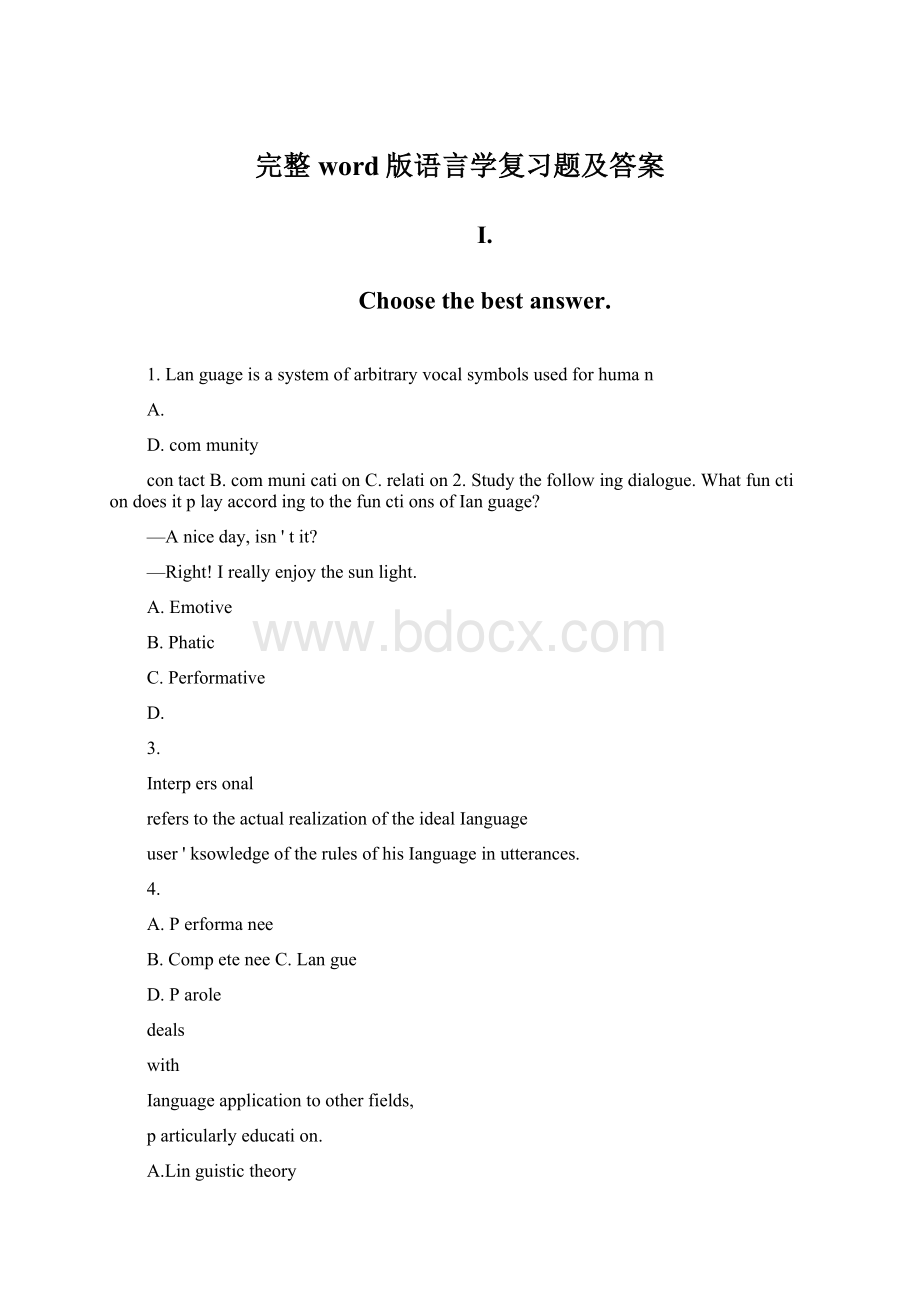完整word版语言学复习题及答案.docx
《完整word版语言学复习题及答案.docx》由会员分享,可在线阅读,更多相关《完整word版语言学复习题及答案.docx(22页珍藏版)》请在冰豆网上搜索。

完整word版语言学复习题及答案
I.
Choosethebestanswer.
1.Languageisasystemofarbitraryvocalsymbolsusedforhuman
A.
D.community
contactB.communicationC.relation2.Studythefollowingdialogue.WhatfunctiondoesitplayaccordingtothefunctionsofIanguage?
—Aniceday,isn'tit?
—Right!
Ireallyenjoythesunlight.
A.Emotive
B.Phatic
C.Performative
D.
3.
Interpersonal
referstotheactualrealizationoftheidealIanguage
user'ksowledgeoftherulesofhisIanguageinutterances.
4.
A.Performanee
B.CompeteneeC.Langue
D.Parole
deals
with
Ianguageapplicationtootherfields,
particularlyeducation.
A.Linguistictheory
B.Practicallinguistics
C.Appliedlinguistics
5.
D.Comparativelinguistics
answerssuchquestionsashowweasinfants
acquireourfirstlanguage.
A.PsycholinguisticsB.Anthropologicallinguistics
6.
Pitchvariationisknownas
whenitspatternsare
imposedonsentences.
A.intonationB.toneC.pronunciation
D.voice
7.
Conventionallya
isputinslashes(//).
A.allophoneB.phoneC.phoneme
D.morpheme
8.
Anaspiratedp,anunaspiratedpandan
unreleasedpare
ofthepphoneme.
A.analogues
B.tagmemesC.
morphemes_D.
allophones
9.Theopeningbetweenthevocalcordsissometimesreferredtoas
_A.glottis
B.vocalcavity
C.pharynx
D.
A.wide
B.closingC.narrow
D.centering
uvula10.Thediphthongsthataremadewithamovementofthetongue
diphthongs.
towardsthecenterareknownas
11.Aphonemeisagroupofsimilarsoundscalled
A.minimalpairs
B.allomorphsC.phones
D.
allophones12.Whichbranchofphoneticsconcernstheproductionofspeech
sounds?
A.Acousticphonetics
B.Articulatoryphonetics
13.
Which
oneisdifferentfromtheothersaccordingtoplacesof
articulation?
14.
A.[n]
Which
B.[m]
C.[b]
D.[P]
vowelisdifferentfromtheothersaccordingtothe
characteristicsofvowels?
A.[i:
]
B.[u]
C.[e]
D.[i]
15.
Whatkindofsoundscanwemakewhenthevocalcordsare
vibrating?
A.Voiceless
B.Voiced
C.Glottalstop
D.
16.
Consonant
Nouns,verbsandadjectivescanbeclassifiedas
A.lexicalwords
B.grammaticalwords
C.functionwords
D.formwords
17.
called
18.
A.inflectional
Thereare
B.free
C.bound
D.derivational
morphemesintheworddenationalization.
A.three
B.four
C.five
D.six
Morphemesthatrepresenttense,number,genderandcaseare
morpheme.
19.
A.prefixes
B.suffixes
C.infixes
D.stems
InEnglish-seand—onarecalled
20.
Thethreesubtypesofaffixesare:
prefix,suffixand
B.
A.derivationalaffix
inflectionalaffixC.infixD.
back-formation
21.
isawayinwhichnewwordsmaybeformedfrom
alreadyexistingwordsbysubtractinganaffixwhichisthoughttobepart
oftheoldword.
A.affixation
B.back-formation
C.insertion
D.
22.
addition
ThewordTBisformedinthewayof
A.acronymy
B.clipping
C.initialism
D.
23.
blending
Thewordslikecomsatandsitcomareformedby
A.blending
B.clipping
C.back-formation
D.
acronymy
24.
Thestemofdisagreementsis
A.agreementB.agree
C.disagreeD.disagreement
25.
Allofthemaremeaningfulexceptfor
A.lexemeB.phonemeC.morpheme
D.allomorph
26.
Thesentencestructureis
A.onlylinear
B.onlyhierarchical
C.complex
D.bothlinearandhierarchical
27.ThesyntacticrulesofanyIanguageare
innumber.
A.large
B.small
C.finite
D.infinite
28.The
rulesaretherulesthatgroupwordsandphrasesto
formgrammaticalsentences.
A.lexicalB.morphologicalC.linguisticD.combinational
29.Asentenceisconsideredwhenitdoesnotconformtothe
grammaticalknowledgeinthemindofnativespeakers.
A.rightB.wrong
C.grammatical
D.
ungrammatical
30.A
intheembeddedclausereferstotheintroductory
wordthatintroducestheembeddedclause.
A.coordinatorB.particle
C.preposition
D.
subordinator
31.Phrasestructureruleshave
properties.
A.recursive_B.grammaticalC.social
D.functional
32.
Phrasestructurerulesallowustobetterunderstand
A.howwordsandphrasesformsentences.
B.whatconstitutesthegrammaticalityofstringsofwords
C.howpeopleproduceandrecognizepossiblesentences
D.alloftheabove.
33.Theheadofthephrase
“thecityRome”is
A.thecity
B.RomeC.city
D.thecityRome
34.
construction.
Thephrase“ontheshelf”belongsto
D.
A.endocentricB.exocentricC.subordinate
coordinate
35.Thesentence“Theywerewantedtoremainquietandnottoexpose
themselves.”isa
sentence.
A.simpleB.coordinateC.compound
D.complex
36.Thenamingtheoryisadvaneedby
A.Plato_
B.Bloomfield
C.GeoffreyLeech
D.Firth
37.“CanIborrowyourbike?
“Youhaveabike.”
A.issynonymouswith
B.isinconsistentwith
38.
C.entails
A.Predicationanalysis
B.Componentialanalysis
C.Phonemicanalysis
D.Grammaticalanalysis
39.“Alive”and“dead”
are
A.gradableantonyms
B.relationalantonyms
D.presupposes
isawayinwhichthemeaningofawordcanbe
dissectedintomeaningcomponents,calledsemanticfeatures.
C.
40.
D.Noneoftheabove
complementaryantonyms
dealswiththerelationshipbetweenthelinguistic
elementandthenon-linguisticworldofexperienee.
A.Referenee
B.Concept
C.SemanticsD.Sense
41.
referstothephenomenonthatwordshaving
differentmeaningshavethesameform.
D.Hyponymy
A.PolysemyB.SynonymyC.Homonymy42.Wordsthatarecloseinmeaningarecalled
A.homonymsB.polysemiesC.hyponymsD.synonyms
isconsidered.
43.Whatessentiallydistinguishessemanticsandpragmaticsis
whetherinthestudyofmeaning
A.referenee
B.speechactC.practicalusage
D.
context
44.Asentenceisa
concept,andthemeaningofasentence
isoftenstudiedinisolation.
A.pragmatic
B.grammatical
C.mental
D.
conceptual45.Ifwethinkofasentenceaswhatpeopleactuallyutterinthecourseofcommunication,itbecomesa(n)
D.expressive
A.constativeB.directiveC.utteranee46.Speechacttheorydidnotcomeintobeinguntil
A.inthelate50'softhe20thecenturB.intheearly1950
C.inthelate1960's
D.intheearly21st
47.
century
istheactperformedbyorresultingfromsaying
something;itistheconsequeneeof,orthechangebroughtaboutbythe
utteranee.
A.Alocutionaryact
B.Anillocutionaryact
C.Aperlocutionaryact
D.Aperformativeact
48.
isabranchofgrammarwhichstudiestheinternalstructur
eofwordsandtherulesbywhichwordsareformed.
49.A.Syntax
B.GrammarC.Morphology
D.Mor
pheme
50.
areoftenthoughttobethesmallestmeaningfulunitsof
languagebythelinguists.
A.WordsB.MorphemesC.PhonemesD.Sentences
51.“-s”intheword“books”is
52.A.aderivativeaffix
B.astemC.aninflectionalaffi
D.aroot
53.Boundmorphemesareclassifiedintotwotypes:
___affix
and
boundroot
54.Thetheoryof
conditionexplainsthefactthatnoun
phrasesappearonlyinsubjectandobjectpositions.
55.
referstothephenomenonthatwordshavingdifferent
meaningshavethesameform.
A.PolysemyB.SynonymyC.Homonymy
D.Hyponymy
56.Thegrammaticalityofasentenceisgovernedby
C.semanticrules
D.semanticfeatures
57.Whatessentiallydistinguishessemanticsandpragmaticsiswhether
inthestudyofmeaning
isconsidered.
A.reference
B.speechactC.practicalusage
D.
context
58.Asentenceisa
concept,andthemeaningofasentenceis
oftenstudiedinisolation.
A.pragmatic
B.grammatical
C.mental
D.
conceptual59.Ifwethinkofasentenceaswhatpeopleactuallyutterinthecourse
ofcommunication,itbecomesa(n)
A.constativeB.directive
C.utterance
D.expressive
60.Whichofthefollowingistrue?
A.Utterancesusuallydonottaketheformofsentences.
B.Someutterancescannotberestoredtocompletesentences.
C.Noutterancescantaketheformofsentences.
D.Allutterancescanberestoredtocompletesentences.
A.inthelate50
65.Speechacttheorydidnotcomeintobeinguntil
'softhe20thecenturBy.intheearly1950
C.inthelate1960's
D.intheearly21st
century
66.
istheactperformedbyorresultingfromsaying
something;itistheconsequenceof,orthechangebroughtaboutbythe
utterance.
A.Alocutionaryact
B.Anillocutionaryact
C.Aperlocutionaryact
D.Aperformativeact
67.AccordingtoSearle,theillocutionarypointoftherepresentativeis
A.togetthehearertodosomething
B.
'sbeingthecase
tocommitthespeakertosomething
C.tocommitthespeakertosomefuturecourseofaction
D.toexpressthefeelingsorattitudetowardsanexistingstateofaffairs68.Alltheactsthatbelongtothesamecategorysharethesamepurpose,
buttheydiffer
A.intheirillocutionaryacts
B.intheirintentionsexpressed
C.intheirstrengthorforce
D.intheireffectbroughtabout
69.
A.CooperativePrinciple
B.PolitenessPrinciple
isadvancedbyPaulGrice
C.TheGeneralPrincipleofUniversalGrammarD.Adjacency
Principle
70.Whenanyofthemaximsunderthecooperativeprincipleisflouted,
mightarise.
fatherofmodernlinguistics
A.Firth
B.SaussureC.Halliday
D.Chomsky
71.Thepersonwhoisoftendescribedas
72.ThemostimportantcontributionofthePragueSchooltolinguisticsis
thatitseeslanguageintermsof
A.function
B.meaning
C.signs
D.system
73.Theprincipal
representativeofAmericandescriptivelinguisticsis
A.Boas
B.Sapir
C.Bloomfield
D.Harris
74.Generallyspeaking,the
specifieswhetheracertain
tagmemeisin
theposition